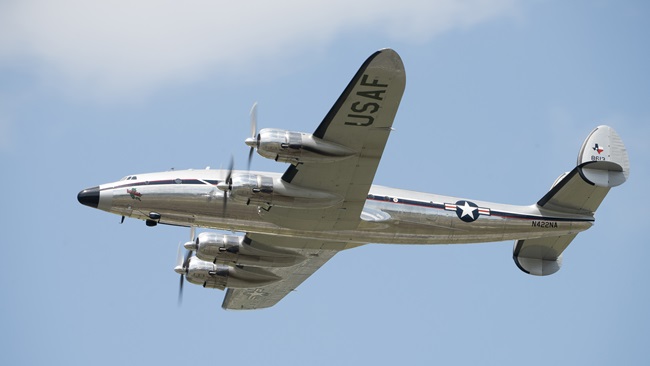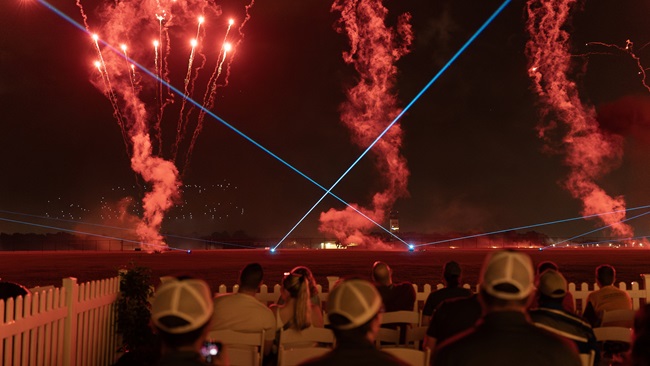History on parade
Veterans share spotlight at fiftieth Commemorative Air Force show
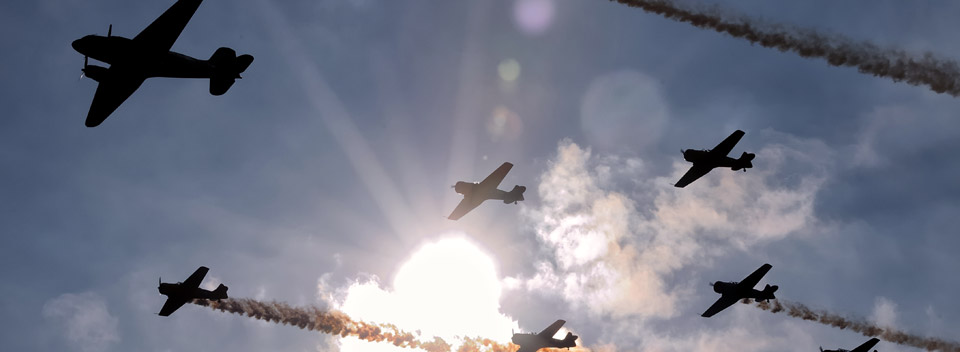

For 50 years, members of the Commemorative Air Force have gathered each fall to present an airshow featuring the organization’s vintage military aircraft, primarily from the World War II era. CAF’s Airsho isn’t just about warbirds and civilian airshow acts, however; it has become a magnet for former military aviators, and regularly plays host to veterans’ groups.
The organization, then known as the Confederate Air Force, began the annual event in 1963 at what it dubbed Rebel Field in Harlingen, Texas—today operating as Valley International Airport—with only nine airplanes in attendance. Now the CAF has a fleet of 159 warbirds, many of which flew over Midland, Texas, during the fiftieth anniversary show, held October 12 and 13, 2013. The weather was perfect for the first day of the event, but Sunday morning dawned with a low overcast that began to lift at midday, just in time for torrential rains to move into the area. Sunday’s airshow eventually was cancelled.
As one might expect, the CAF’s fleet of former military aircraft dominated the airshow, and included the CAF’s choreographed “Tora, Tora, Tora” re-creation of the December 7, 1941, Japanese attack on Pearl Harbor that brought America into World War II. Rare aircraft operated by the organization—including FIFI, the only flying B–29 Superfortress, and Diamond Lil, one of only two airworthy B–24 Liberators—took part in the show, as well as two B–17 Flying Fortresses, several B–25 Mitchells, and a variety of fighters, trainers, transports, and other aircraft. Two of only three original Japanese A6M Zeros still flying took to the skies; one of them was part of a contingent from the Texas Flying Legends Museum in Houston.
Although current military aircraft were absent from the airshow, courtesy of the federal government sequestration, several civilian acts were featured, including Jan Collmer in his Extra 300L; Andrew Wright flying a Giles G–202; the father-and-son team of Greg and Joe Shetterly, who performed together and separately; and the FLS Microjet, billed as the world’s smallest jet airplane.
Two distinguished groups of veterans convened in Midland during the weekend of the CAF airshow. Pilots who flew the QU–22B, a heavily modified Beechcraft Bonanza, in Vietnam got together for the first time since they served together in Southeast Asia more than 40 years ago. Primarily members of the 554th Reconnaissance Squadron, their mission consisted of orbiting above the Ho Chi Minh Trail between 20,000 and 25,000 feet; their aircraft served as radio relays for acoustic and vibration sensors dropped along the trail to detect movement. A restored QU–22B was on hand at Midland and flew in the airshow.
Members of the 456th Bomb Group, which operated and maintained B–24 Liberators as part of the Fifteenth Air Force in the European theater during World War II, held their first reunion in 1971, and have gone back to Italy three times since then. However, next year will be the group’s final reunion; now, age is taking its toll on these combat survivors.
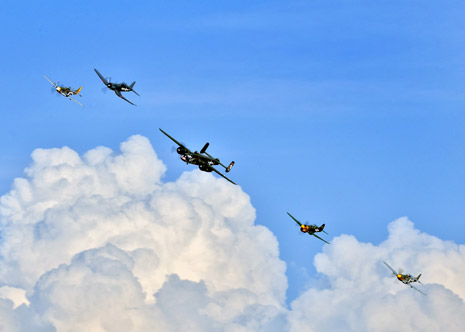
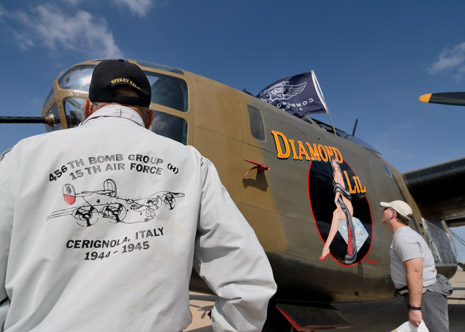
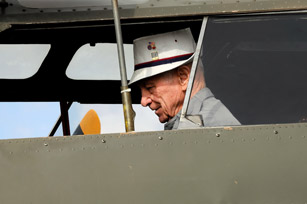
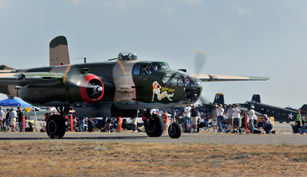
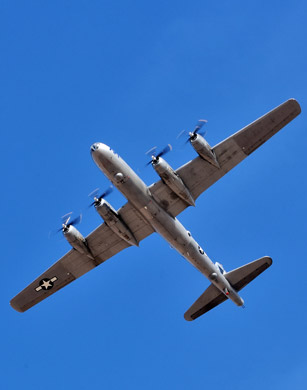
Garfield Klinger, 91, of Puyallup, Washington, flew the B–24 during World War II. With his wife and other family members in tow, he climbed into the cockpit of Diamond Lil, CAF’s B–24A, and sat in the left seat of an airworthy Liberator for the first time since 1944. It was emotional to sit there again, he said. “I didn’t spend many hours in there, you know. You flew missions—six, seven, eight hours—and you had your training before that. You probably had the lowest time of any airplane I ever flew. It’s just a place where you went to the office every day, and that’s what you did. I’d do it again. But, I don’t feel special. If people say I am, that’s their business.”
Upon graduating from the aviation cadet program, Klinger had a decision to make. “They said B–24s, or B–26s—the old ‘Widowmaker,’ the one that had the short, short wings and small engines.” He chose the B–24. “These are all different kinds of controls than we had on ours,” he said, looking at Diamond Lil’s throttle quadrant. “The trim tab was different…. We had the old coffee-grinder radios.”
Klinger flew 35 missions during nine months in combat. After leaving Italy he flew the B–24 again, at a flight engineer school in Texas. “I flew several missions for the flight engineers—they had them rigged up in the back. And then later on, flight engineers flew with me on all my flights in C–124s.” He flew the large, four-engine cargo airplanes for more than 6,000 hours, and retired from the Air Force with 22 and one-half years of service.
He wasn’t done with the B–24, however. Two sons who accompanied him to Texas bought rides for Klinger; his wife, Jeanne; and themselves aboard the historic aircraft. As they climbed down from the Liberator’s cockpit, Klinger’s wife whispered to a CAF crewmember that she learned more about her husband’s military service that day than she had learned in 70 years of marriage.
Frank Amaditz of Pittsburgh was a bomb group member who served on the ground. “I was in photography. Our job was putting cameras in the planes, and when the planes came back from the missions, we took the cameras off the planes, took them back to the lab, processed the film, and got the pictures ready for our colonel. He wanted to see what we did or didn’t do.”
In Italy, bomb group members lived in olive orchards. Amaditz still recalls how the group would launch the lumbering bombers for missions. “They had them on the runway three at a time—one at the beginning, one at the middle, and one [taking] off at the end.”
George W. Boe of Pearland, Texas, was looking for the Liberator’s top machine gun turret, a feature that the CAF’s Diamond Lil does not have. “The wing commander came out to fly a mission with our group,” he recalled. “He climbed into the front turret and flew the whole mission up there in the turret—a brigadier general!”
Boe was an early airborne radar operator, part of a program that was secret at the time. “It was codenamed Mickey,” he said.
He recalled an unexpected bailout on a bombing mission. “We had a bombardier fall asleep after dropping [bombs] on a raid,” he said. “He woke up in an overcast and got so excited, he bailed out through the nose-gear door. He showed up at one of our reunions 40 years later.”
Frank Moore of Hays, Kansas, was a crew chief, but crew chiefs seldom flew on missions. “[Crewmen] didn’t like to fly with anyone who wasn’t part of the crew,” he explained, but occasionally a replacement gunner was required. “I got six or seven combat missions.” Most of his duty was on the ground. “We would preflight the night before, and then come back and preflight again in the morning.”
If there was a prop or engine problem, the ground crew would switch it out with a spare. Burned-out generators were common. “It was almost easier to change an engine,” Moore recalled. “Changing the tire was a bigger deal. The sad part of it was when they came back from a mission and were shot up—you could imagine what it was like on the inside.”
Moore helped organize the bomb group’s first reunion, in 1971. Three years later, members went back to Italy for the first time. “I think it was just amazing how those Italian people went out and packed the streets,” he said. “We went back three times.”
Next year will be the group’s last reunion, added Moore, 90.
Email [email protected]


